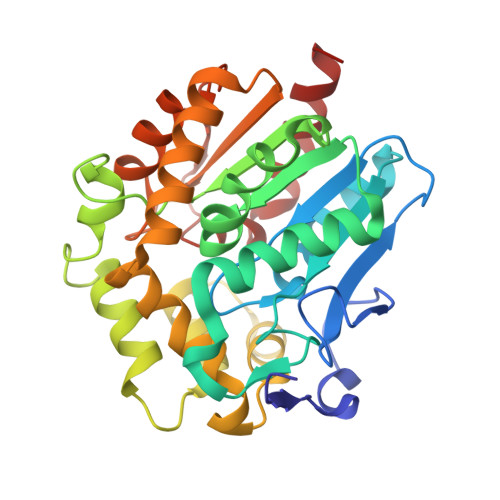The effect of deuteration on protein structure: a high-resolution comparison of hydrogenous and perdeuterated haloalkane dehalogenase.
Liu, X., Hanson, B.L., Langan, P., Viola, R.E.(2007) Acta Crystallogr D Biol Crystallogr 63: 1000-1008
- PubMed: 17704569
- DOI: https://doi.org/10.1107/S0907444907037705
- Primary Citation of Related Structures:
2PKY, 2YXP - PubMed Abstract:
Haloalkane dehalogenase from Xanthobacter autotrophicus (XaDHL) was overexpressed under different isotopic conditions to produce fully hydrogenous (h-XaDHL) and perdeuterated (d-XaDHL) enzyme forms. Deuterium atoms at labile positions were allowed to back-exchange during purification and hydrogenous solutions were used for crystallization. Optimal crystals of h-XaDHL and d-XaDHL were obtained under different pH conditions (pH 6.0 and 4.6, respectively) but had similar P2(1)2(1)2 unit cells. X-ray diffraction data were refined to 1.53 A (h-XaDHL) and 1.55 A (d-XaDHL) with excellent overall statistics. The conformations of h-XaDHL and d-XaDHL are similar, with slightly altered surface regions because of different packing environments, and h-XaDHL is found to have a more hydrophobic core than d-XaDHL. The active site of h-XaDHL is similar to those of previously determined structures, but the active site of d-XaDHL unexpectedly has some crucial differences. Asp124, the primary nucleophile in the hydrolysis of haloalkane substrates, is displaced from its position in h-XaDHL and rotates to form a hydrogen bond with His289. As a consequence, the water molecule proposed to function as the nucleophile in the next catalytic step is excluded from the active site. This is the first observation of this unusual active-site configuration, which is obtained as a result of perdeuteration that decreases the hydrophobicity of the enzyme, therefore shifting the optimal pH of crystallization. This d-XaDHL structure is likely to represent the termination state of the catalytic reaction and provides an explanation for the acid inhibition of XaDHL. These results underline the importance of carefully verifying the assumption that isotopic substitution does not produce significant structural changes in protein structures.
Organizational Affiliation:
Department of Chemistry, University of Toledo, Toledo, OH 43606, USA.














